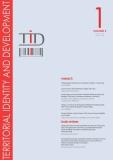VISUAL IMAGERY AND CONSTRUCTION OF TERRITORIAL IDENTITY THROUGH ICONIC BUILDINGS. CASE STUDY: THE ROMANIAN ATHENAEUM, BUCHAREST
VISUAL IMAGERY AND CONSTRUCTION OF TERRITORIAL IDENTITY THROUGH ICONIC BUILDINGS. CASE STUDY: THE ROMANIAN ATHENAEUM, BUCHAREST
Author(s): Florentina-Cristina Merciu, Oana Ramona Ilovan, Andreea-Loreta CercleuxSubject(s): Museology & Heritage Studies, Architecture, Rural and urban sociology, Sociology of Culture, Tourism, Politics and Identity, History of Art
Published by: Universitatea Babeş-Bolyai
Keywords: built heritage; iconic architecture; representations; picture postcards; cultural and national identity;
Summary/Abstract: The built heritage, through the multiple meanings it associates (oldness, architectural, aesthetic, symbolic, authenticity), is characterized by uniqueness and irreversibility, being frequently related to the cultural and implicitly tourist image of cities. Due to the seniority of architectural heritage and the special relations established with the place and people, under the direct influence of the socio-cultural and political factors, it ensures the accumulation of symbols that codify the urban space. As a result, heritage buildings are associated with elements of territorial identity. Visual imagery is used as an argument to support the process of selecting significant buildings for local / national culture. These are promoted among the general public. Most of the time, the selection process aim s at identifying representative buildings, a process that registers the influence of socio-cultural and politic factors. This article focuses on the socio-cultural evolution of the Romanian Athenaeum, a symbolic building of the Romanian culture. Based on a rich background of historical illustrations and recent observations, the authors analysed the symbols associated with the Romanian Athenaeum, in various historical periods. The authors used a sample of picture postcards with representations of the Athenaeum and interpreted the information they provided. The key results show the cultural role of the Athenaeum for the capital city, Bucharest, and its relation with the political factor, as this building was selected as the host for important political events with a deep historical charge, most often having the support of national authorities. In the course of time, the Athenaeum was represented constantly in picture postcards, as cultural building symbol and tourist attraction, due to its unique characteristics which emphasize its role as element of urban identity for Bucharest. At the same time, the interpretation of visual imagery allowed the decoding of the symbols and identification of the identity narrative and politics built around the Athenaeum, which, through the interactions generated by the socio-cultural and political plans, confer it the quality of symbolic building for the national and European culture.
Journal: Territorial Identity and Development
- Issue Year: 5/2020
- Issue No: 1
- Page Range: 37-67
- Page Count: 31
- Language: English

